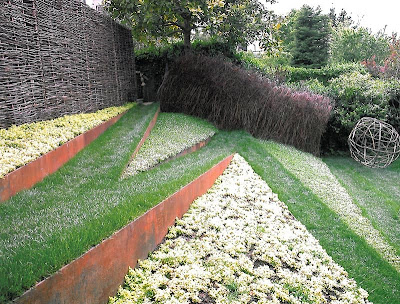I’ve had the book ‘Andrea Cochran: Landscapes’ for a while now, since Princeton Architecture Press (2009) sent me a copy. I’ve paged through it numerous times, but figured I’d get around to reading it at some point, at least formally, before putting the review together. Well, for a review I have to admit that I didn’t end up reading much of it, but rather poured through the pages, scanning, absorbing, and staring at small vignettes of material and spatial form. Much like her work, the book is something to savor and view, but not necessarily an overly intellectual pursuit. This isn’t to demean the work at all, as I’m sure there’s a weighty sum of theory and background that the work is built on. It’s a complement. Like art, you can view it and feel it, rather than read about it and think on it. This book gives you plenty to feel – and really, that’s the best part.
I definitely will preface this ‘mash note’ to say that I am a huge fan of Andrea Cochran’s work – and thus this review will focus less on the work than on the presentation here. Between the black stained concrete of the Perry Residence and the wonderfully whimsical Children’s Garden (shown below) as some of the first projects I had seen from Cochran, I was immediately struck with the intricate simplicity of materials and form, yet blown away by the power of such restraint.
The book doesn’t disappoint, as it is image-rich – offering many views of some of the fine work of the firm. Projects include a quick synopsis, a graphic plan, and both long and detailed views, exploring not just the overall form, but the connections and interplay of corten steel and grass, stainless and succulants, black concrete and decomposed grey granite. For instance one of my favorite projects, the Hayes Valley Roof Garden – shows wonderful composition of form and materials – powerful in plan and in reality.
It’s also fascinating to see a larger body of work, connecting the above 2002 project and the follow up Ward Residence, which re-purposes the sinuous forms of Hayes Valley into a similar set piece – including stone and larger trees that were not possible in the rooftop scenario.
There is an opening essay by author Mary Myers describing some of the philosophy of the firm. It’s a good read – and mostly a great way of summarizing both the historical origins of modern landscape architecture and the influence of the larger construct of art theory. But this isn’t necessarily the type of work that needs words, and it’s good to see that there’s many more images than long descriptions of project directives. The materials are authentic and the focus on the creation of space is overt. Words would just get in the way.
The imagery of the Brookvale Residence (above) shows a simplicity of plantings, using hedges of Equisetum to create spaces; a different mood is evoked at the Stone Edge Vineyard (below) with native oaks, sculptural bay and olive trees, massing of ornamental grasses and water, in this case the lap pool expanding into a distant vanishing point through a small opening in the trees, with the the contrastingly rusty facade of the observatory building to the right.
While minimalist, the work is definitely infused with a regional sensibility – co-opting distant view and existing vegetation, as well as showcasing the original sculptural approach to landscape – again from the Stone Edge Vineyard and the ancient olive and bays in a simple field of gravel.
The end of the book offers some detailed line drawings of the spaces, which are just a minimal as the landscapes themselves. These are divided into plantings and built elements – giving some idea of the component items of the spaces. For instance, the image below shows the specifics on the Portland Art Museum exterior courtyard – one of the fine examples of Cochran’s work locally. As a designer, these are a nice touch to be able to see the specific materials, colors of Scofield pigmented concrete, and plantings.
The above image captures one aspect of the beauty of this book – and why it transcends the typical photogenic monograph by showing wonderful projects, beautifully photographed, and just enough supporting info to make it resource as well. While the intro is worthwhile, and the project profiles are short and sweet – there’s some meat to the beauty… even if that may reinforce that you can create poetry with a few simple materials, artfully arranged. It showcases both beautiful planting design, but a different side of the profession of landscape architecture. Thoroughly modern, minimal – yet still somehow verdant and contextual. It’s an inspiration to see – if not to read.
[all images included are from the book]











Beautiful work!
I like the book a lot.
I admire Andrea Cochran work is creative,natural and armonic.
Great book!
we do have this book in our office — just recently purchased — and i love it! More picture, less words.
i could need some data or pictures about Andrea Cochran Perry Residence to finish my report.
please~~~~~~~
i could need some data or pictures about Andrea Cochran Perry Residence to finish my report .
could anybody help me please~~~~~